At the time of its release in 2010, the Cor i3-540 made it possible to assemble computer configurations that were average in terms of performance. Now it continues to be relevant and still allows you to run most existing software. It is its capabilities and technical parameters that will be discussed further.
Chip positioning
Like all CPUs in this family, it belongs to mid-level chips. Their performance level is quite sufficient to solve most problems. And even today's most demanding toys can run on it, only if the settings are not maximum and a very productive system is installed. This processor has a sufficient level of performance, but not excessive. Therefore, all such CPUs are excellent for mid-range PCs.
Socket
The Core i3-540 is designed for installation in the LGA 1156 socket. Quite a lot of time has passed since its announcement. Intel has already updated its processor sockets three times. Therefore relevant this decision can no longer be counted.
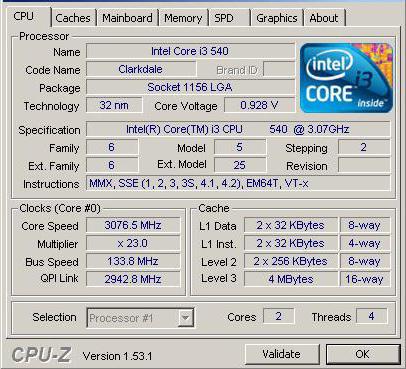
Technological process. Temperature. Thermal package
The i3-540 processor had a dual-chip design. One of them housed two computing cores and was produced using 32 nm technology, and the second had an integrated graphics accelerator, which had already been produced using 45 nm standards. The maximum permissible temperature for this semiconductor crystal was 72.6 ° C. In reality, the temperature range was between 35 and 50 ° C. The thermal package of this semiconductor solution was 73 W. Taking into account the technology, the layout of the crystal and the presence on it of not only computing cores, but also a graphics accelerator and controller random access memory this is normal value.
Cash
"Kor i3-540" is equipped with a cache memory of 3 levels. The first of them was equal to 128 KB and was divided into 2 equal parts of 64 KB, which could only interact with one core. These 64 KB, in turn, were still divided in half. One of the 32 KB parts was used to store instructions, and the second of a similar size was used for data. The total size of the second level cache was already 0.5 MB. It was also divided into 2 parts of 256 KB each, which were defined behind the computing module. The third cache level was shared and its total size was 4 MB.
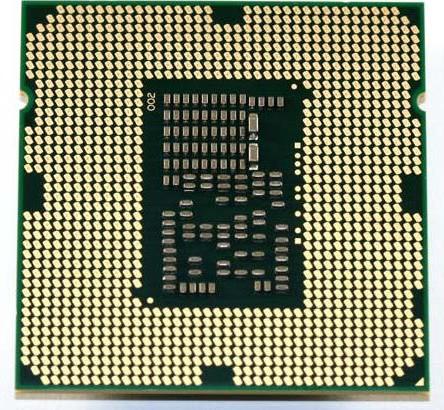
RAM
The RAM controller has been moved from north bridge recruitment system logic in "Cor i3-540" on the central processor chip. This made it possible to significantly increase the speed of the RAM subsystem. The controller itself was dual-channel and oriented towards installing DDR3 memory sticks. Their recommended frequency should be 1066 MHz or 1333 MHz. The maximum size of RAM in this case could reach 16 GB.
Frequency
The multiplier for this processor solution is blocked; TurboBust technology is also not supported in this case. The frequency is 133 MHz, and the chip frequency multiplier is 23. Therefore clock frequency this CPU is 3.066 GHz. This is a fixed value that does not change either from the load on the processor or from the degree of its heating.
Architecture
Two physical processor cores are included in this representative of the Cor i3 line. CPU 540 supported HyperTrading technology. When activated, it was possible to obtain four information processing threads instead of the usual two computing cores. Therefore, at the software level, this processor looked like a full-fledged quad-core solution. In reality, it was inferior in performance to four-module processors of the Cor I5 family.
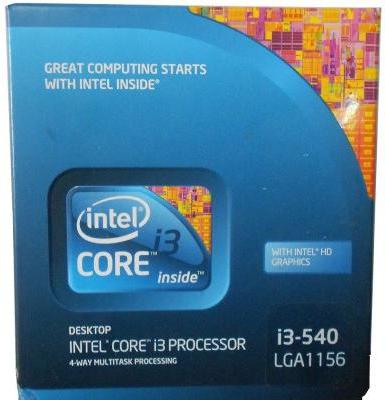
Graphic arts
As noted earlier, the Core i3-540 includes an integrated graphics accelerator. Its model is HD Graphics. of this computing solution was 733 MHz. It could display images on 2 monitors at once. His level of productivity was minimal, and he could only decide the most simple tasks (office applications, simple games and video playback). For anything more, it was necessary to purchase a discrete accelerator that would allow the full capabilities of this semiconductor crystal to be revealed.
Overclocking
As noted earlier, the frequency multiplier for this CPU was locked at 23. Therefore, it was simply impossible to overclock this processor with its help. But the value of the system bus frequency could still be changed. As a result, the overclocking capabilities of this chip were minimal. To do this, it was enough just to raise its value. This made it possible to obtain an additional 3-7 percent increase in productivity.
Review Intel Core The i3-2100 will focus on processor performance compared to earlier models in this price range. You will find out how many cores the Intel Core i3-2100 has, which core and other specifications, and also find tests on various games.
Intel LGA1155 processor Sandy Bridge simply fantastic, but still its influence on the budget processor market is not so great yet. The dual-core Core i3-2100 retails for $124, which is very attractive. At first glance, the i3-2100 seems like a lightweight CPU. It does not support Turbo Boost, and does not have the 'K' marking, which indicates the presence of unlocked multipliers. All this means that the i3-2100 is not aimed at winning the laurels of the best budget CPU for overclocking.
Moreover, now that many applications and games are announced that use four or more cores, it is clear that the dual-core i3-2100 will not be relevant for a long time. The only thing that saves it is the presence of Hyper-Threading, thanks to which two logical cores are added. However, the i3-2100 clocks at 3.1GHz and has a 32nm core, with Intel promising a maximum power consumption of 65W - a third less than the quad-core Core i5-2500K.
Compared to the i5-2500K, the Core i3-2100 processor only has 3 MB of L3 cache (while the i5-2500K has 6 MB). However, with 256KB of L2 cache per core, it should provide excellent performance for most tasks.
The i3-2100 also features Intel HD Graphics 2000, but you'll need an H67 or Z68 (not P67) motherboard to take advantage of it. Module GPU(GPU) is slightly improved (including support for DirectX 10.1) relative to the modules that were supplied with the previous generation of Intel Clarkdale processors.
Thus, the GPU is designed to take on time-consuming tasks such as video encoding without CPU involvement. This means that the most modest H67-based systems will be much better suited to multitasking, especially if your budget does not include a discrete graphics card in your computer.
Description of the i3-2100 specification
- Frequency 3.1 GHz
- Core Intel Core i3-2100 - Sandy Bridge
- Production technology 32 nm
- Graphics core Intel HD Graphics 2000
- Number of Cores 2x physical, 2x logical
- Cache Tier 1: 32 KB + 32 KB (per core), Tier 2: 256 KB (per core), Tier 3: 3 MB (total)
- Assembly LGA1155
- Energy consumption factor 65 W
- Peculiarities SSE, SSE2, SSE3, SSE4.2, EM64T, EIST, Execute Disable Bit, Hyper-Threading, VT, AES-NI, AVX, Quick Sync Video
Intel Core i3-2100 tests
To test Intel Core i3-2100 Sandy Bridge processors, we use the Asus P8P67 motherboard, and for AMD CPU tests, we use the Asus Crosshair IV Formula, an excellent overclocked card based on the AMD 890FX chipset. This is a more expensive motherboard than the Gigabyte GA-H55M-UD2H we used for Intel LGA1156 processors, but both cards are capable of pushing maximum performance of the tested CPUs.
Test settings
Software
Here is a list of applications that we used during testing:
- Crysis v1.21
- X3: Terran Conflict rolling demo v1.2.0.0
- WPrime v2.00
- Media Benchmarks v2007.235
- Maxon Cinebench 11.5 (x64)
Windows 7 Home Premium 64-bit OS was used, as the most flexible and reliable of the 64-bit operating systems.
Hardware
- ATI Radeon HD 5870 Graphics Card (Catalyst 10.11 WHQL)
- Hard drive 2 TB Western Digital Caviar Black
- PC Power & Cooling Silencer 750 W power supply
- Motherboards: Asus P8P67 Intel LGA1155 motherboard, Asus P6TD Deluxe Intel LGA1366, Asus Crosshair IV Formula AMD Socket AM3, Gigabyte GA-H55M-UD2H Intel LGA1156.
- Memory 4/6 GB (3 x 2 GB) Corsair 1,600 MHz DDR3
- Cooling the Titan Fenrir TTC-NK85TZ processor, with the exception of LGA1155 systems where the Corsair H50 was used due to the incompatibility of the Fenrir and motherboards Asus P8P67.
Cinebench R11.5 64-bit
Cinebench R11.5 uses the Maxon Cinema 4D engine to render highly detailed, photorealistic images and scenes. These images and scenes contain reflections, environments, and procedural shaders, putting a heavy load on the CPU.
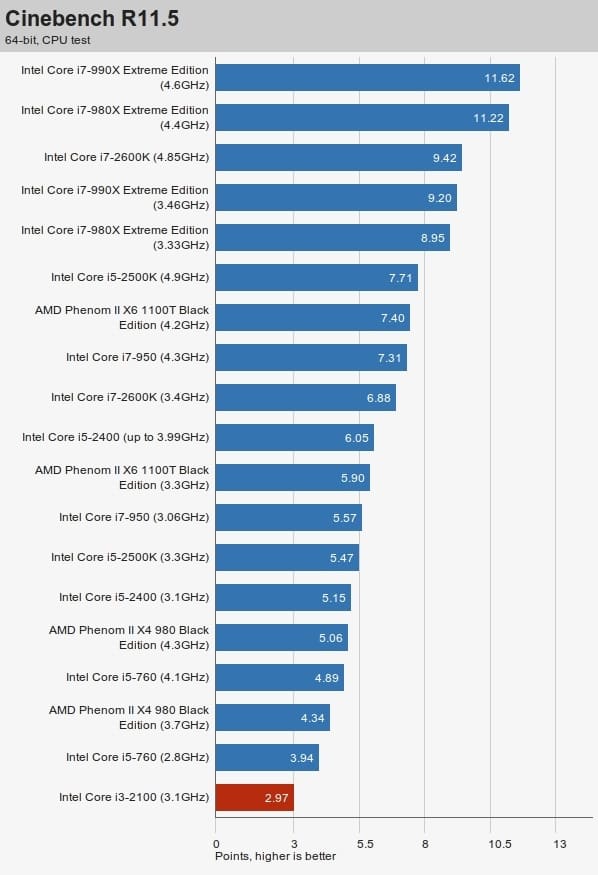
Since Cinema 4D is a real-life application - it was used in the production of films such as Spider-Man and Star Wars - Cinebench R11.5 can be considered a real (not synthetic) performance test.
WPrime
WPrime is a test for the Intel Core i3-2100 about multi-threaded math calculations that use square roots instead of prime numbers. The standard test uses 32 million numbers, calculating the square root through “recursion of Newton's method of estimating a function.” WPrime is well distributed across multiple CPU cores and can provide 100% utilization to all cores.
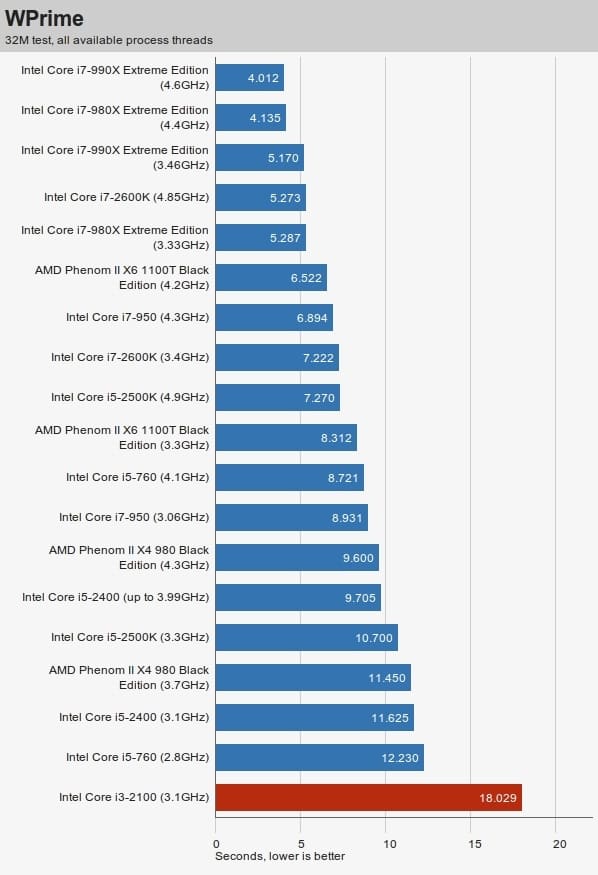
To run the test, it is necessary for the program to recalculate the cores to make sure that WPrime will load both logical and physical cores, and then just start the 32M test. The result will reflect the amount of time it took to calculate the square roots of a certain number of numbers (32 million on the standard test). The smaller the result, the better.
Media tests
We have developed our own set of tests using real applications with open source to simulate normal PC load. The complex included image editing using Gimp, a video encoding test using Handbrake, and a multitasking 7-Zip test, during which files are archived and encrypted. large files, and at this time HD movies are played through mplayer.
A score of 1,000 means that the system under test has the same speed as the original PC, which uses a 2.66 GHz Intel Core 2 Duo E6750 at stock speed, 2 GB of Corsair 1.066 MHz DDR2 memory, HDD 50 GB Samsung SpinPoint P120S and Asus P5K Deluxe WiFi-AP motherboard. The scoring system is linear, so a machine that scores 1,200 points is 20 percent faster than the original machine. Likewise, a system with a score of 1,200 is 4 percent faster than a system with a score of 1,150.
Editing Images
Gimp is an open source image editing application - Gimp is an acronym for the GNU Image Manipulation Program. Our test tests how well a PC can handle a collection of large digital photos and how it achieves the fastest response times by powerful processor, large amounts of fast memory and efficient access to stored data.
Video encoding
We use the open-source, GPL-licensed, multi-platform, multi-threaded video encoder Handbrake to encode HD video using the H.264 codec. First of all, this is a test of CPU multithreading and memory subsystem performance.
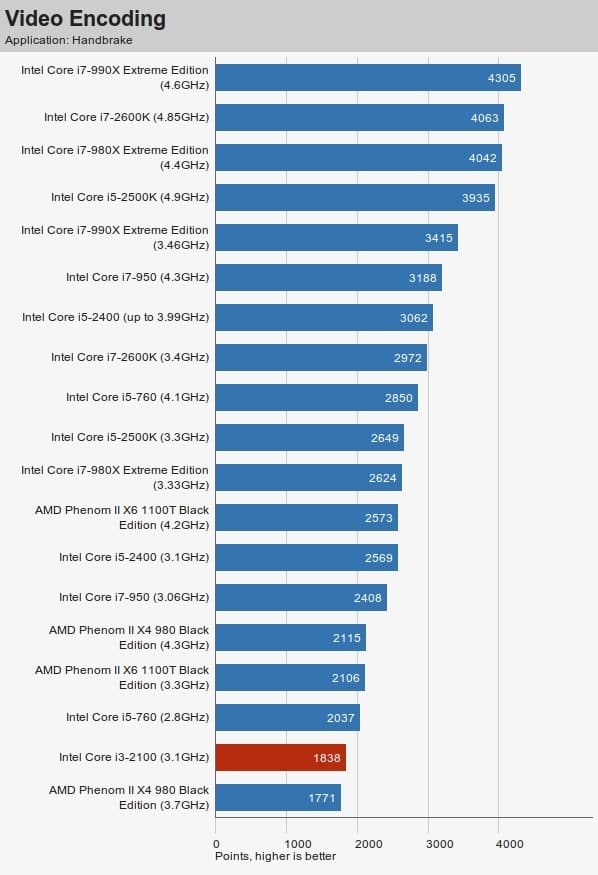
Game tests
Crysis
Although Crysis is not as demanding on the graphics card, it is a great way to show how CPU speed can affect gaming performance. We patched Crysis to version 1.21 and ran it in DirectX 10 mode with high detail settings. The resolution was set to 1,680 x 1,050 without AA or AF to accommodate the real-world workload of the test without the risk of graphics card limitations affecting CPU performance numbers.
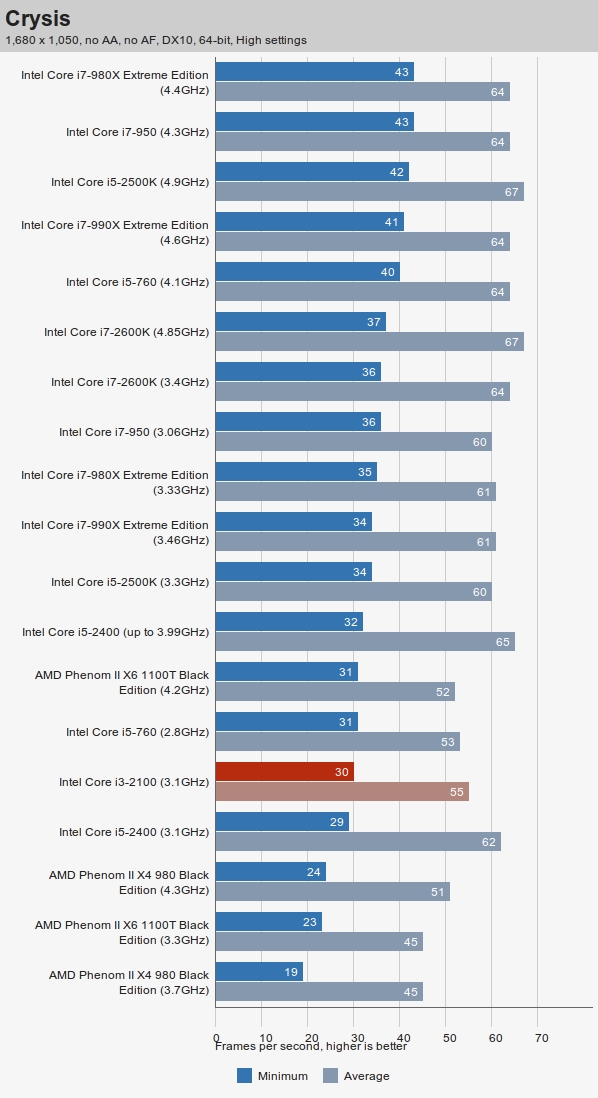
We used the Assault Harbor test in the Crysis testing program to recreate the night battle.
X3:Terran Conflict
X3: Terran Conflict uses a ton of polygons and geometric elements to create complex ship models, so it's quite taxing on the CPU. In addition, it is the CPU that creates models of game objects before the GPU adds shadows and textures.
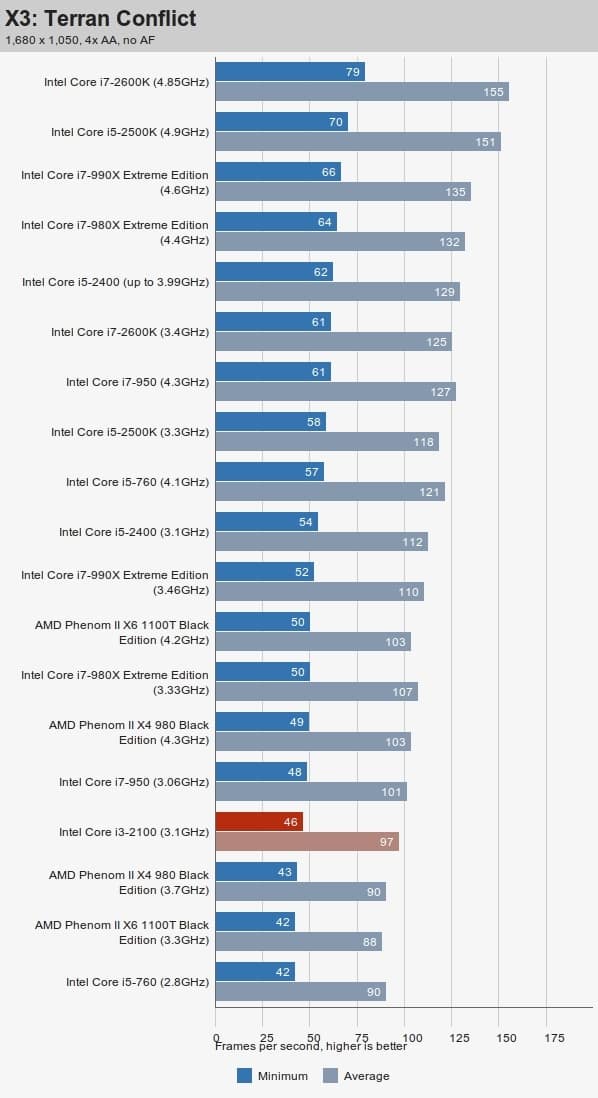
Energy consumption
In all performance tests, we turned off any power-saving technologies in order to obtain adequate results and be able to assess the performance as accurately as possible - even technology like Intel SpeedStep, which helps to gain just a few milliseconds, can have an impact on the results of some tests.
Power consumption is measured using a wattmeter, so the figures shown reflect the power consumption of the system as a whole, but not the consumption of the CPU individually. Measuring the energy consumption of an individual PC element is too complex a procedure.
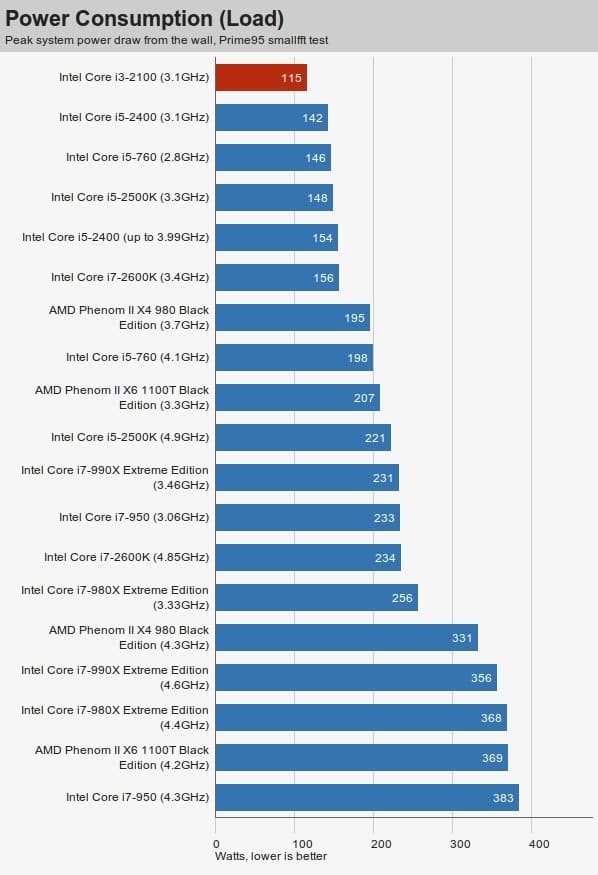
Power consumption in idle mode
In this test, we left the PC in standby mode (only the working Windows table 7 with Aero enabled) for several minutes and recorded the power consumed during this time.
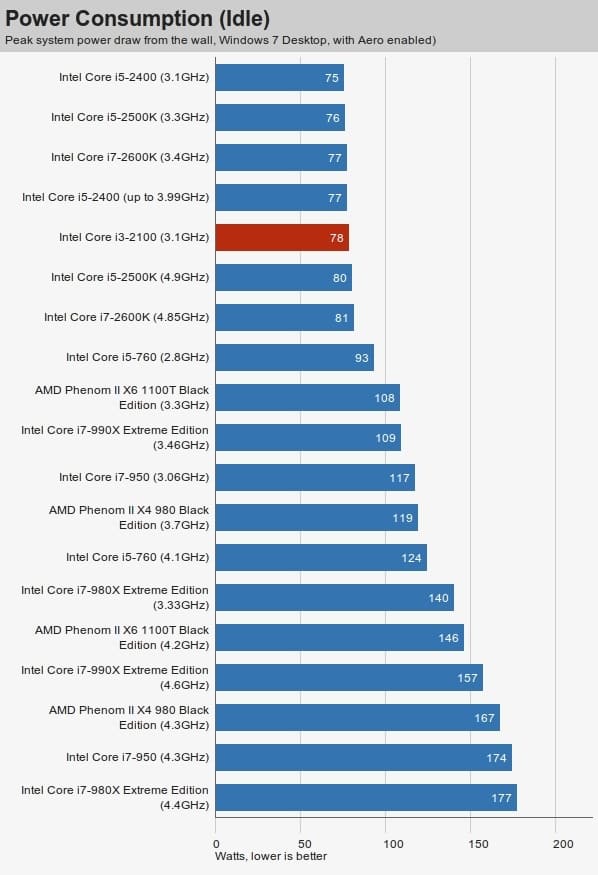
Intel Core i3-2100 Performance Specifications
Since the i3-2100 essentially already runs at a maximum frequency of 3.1 GHz with multipliers locked and no Turbo Boost, we ran the tests just once, instead of getting results from the stock and overclocked versions of the device. Even in this situation, we couldn't help but be surprised by the excellent performance of this processor from the sub-$150 segment.
In our Gimp image editing test, the i3-2100 scored 1,360 points - just 234 points less than the i5-2500K. Incredibly, the i3-2100 was only 16 points behind the LGA1366 Core i7-950, indicating that Sandy Bridge is making the lower tier of LGA1366 processors redundant. He was faster than AMD Phenom II X6 1100T Black Edition.
However, the HandBrake H.264 video encoding test confirmed our fears that, as a dual-core processor, the i3-2100 would not be able to compete in multi-threading with quad-core CPUs. It scored 1,838 points, while the i5-2500K scored 2,649. However, the i3-2100 compares well with the AMD Phenom II X4 980 Black Edition, which scored just 1,771 points despite its 3.7 GHz clock speed and two extra cores.
The i3-2100 also struggled in the multitasking test - its score of 1,196 was easily surpassed by the i5-2500K's 1,423. The i3-2100 processor is again faster than the 980 BE, beating it by more than 100 points. Overall, the i3-2100 scored 1,465 - better than any AMD product - and even enough to give the quad-core Core i5-760 a run for its money, which scored 1,490. But, one way or another, the quad-core Intel Sandy Bridge chips were all ahead of our processor by several hundred points.
Despite having a smaller amount of L3 cache and the absence of two additional cores compared to processors of the same frequency, such as the i5-2400, the i3-2100 processor produces the same minimum fps value in the game Crysis - 30. At the same time, The i5-2400 averaged 52fps, while the i3-2100 averaged 55fps. Once again, the i3-2100 was preferable to any of AMD's offerings. Meanwhile, in the Cinebench R11.5 multi-threaded test, it was not surprising to see the i3-2100 score only 2.97. WPrime covered a similar story, revealing a result of 18.029 seconds - the result of a dual-core i3-2100 - hyper-threading technology versus real four cores.
Energy Intel specifications Core i3-2100 can well be called aggressive - the clock frequency of the i3-2100 in standby mode drops to 1.6 GHz. Our system idle test showed 78W, which is comparable to Intel's Sandy Bridge quad-core processors. Power consumption under load was only 115 W, which is almost 30 W less than the i5-2400.
Intel Core i3-2100: reviews and prices
Despite the lack of Turbo Boost, the i3-2100 showed decent results in many tests, giving food for thought to the LGA1366 Core i7-950 and quad-core Core i5-2400 processors. The most impressive performance was in games and image processing. With a power consumption of 65 W, the processor is especially suitable for light gaming PC or photo processing.
The description above showed that although Intel price The Core i3-2100 is quite attractive, but the i3-2100's refusal to overclock is frustrating. As we've seen with CPUs like the Core i5-2500K, Sandy Bridge chips have huge overclocking potential Intel processor Core i3-2100. Even frequencies above 4.5 GHz are possible, provided good cooling, and the result will be superior performance.
However, according to expert reviews, if you don’t want to spend more than $150 on your next CPU, the i3-2100 is a completely serious option. Adding another $100 will buy you the i5-2500K, but that price increase won't give you a comparable boost in power without overclocking, which in turn requires additional funds. Overall, reviews show that the Intel Core i3-2100 is undoubtedly an excellent choice for building a cheap PC.
Views: (28397)
Send
Cool
Link
Perhaps every home has a computer. Modern life It’s almost impossible to imagine without this device. But what is an integral part of any of these technical devices? Of course, the processor. This is the “brain” of any computer. It is there that all those invisible operations take place that turn a lifeless iron box into the most important assistant and, sometimes, friend.
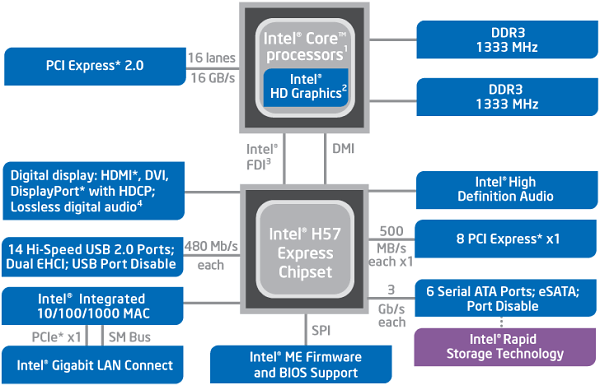 Not long ago, one of the most famous corporations called Intel released a line of the latest H55 and H57 chipsets, which included several processors with an integrated graphics core called HD Graphics, also owned by Intel. These processors exist under the name Clarkdale. The above-mentioned core continues the traditions of the famous Intel GMA X4x00 family. Thus, these processors were created in the LGA1156 form factor, and were divided into several families, such as: Core i5, the no less famous Core i3, as well as Pentium, which in turn had some differences in the frequencies at which they operated, and, as a result, in performance and functionality.
Not long ago, one of the most famous corporations called Intel released a line of the latest H55 and H57 chipsets, which included several processors with an integrated graphics core called HD Graphics, also owned by Intel. These processors exist under the name Clarkdale. The above-mentioned core continues the traditions of the famous Intel GMA X4x00 family. Thus, these processors were created in the LGA1156 form factor, and were divided into several families, such as: Core i5, the no less famous Core i3, as well as Pentium, which in turn had some differences in the frequencies at which they operated, and, as a result, in performance and functionality.
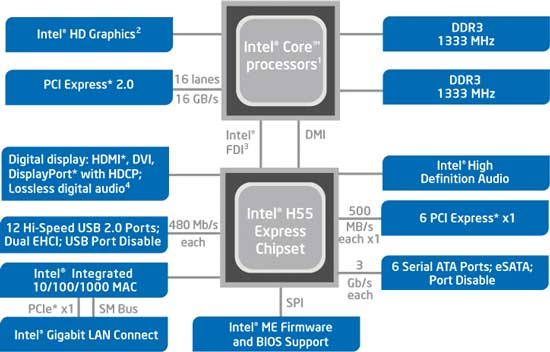 These systems were created with consumers in mind who wanted the least expensive processor possible without compromising on performance and quality. The main task of such devices was aimed at quickly completing assigned tasks that were not particularly difficult. Among all these systems, the cheapest and most frequently used is the Intel Core i3, a second-generation processor. For their level, these models have a fairly high efficiency factor, but there are also disadvantages, one of which is the inability to use the initially integrated graphics core. It may also interfere low performance memory systems, compared to more advanced processors such as Intel Core i5. The cause of these problems is the P55 chipset, which simply does not have the ability to support the required Intel FDI bus. Namely, it is through it that all video signals from the graphics core are transmitted.
These systems were created with consumers in mind who wanted the least expensive processor possible without compromising on performance and quality. The main task of such devices was aimed at quickly completing assigned tasks that were not particularly difficult. Among all these systems, the cheapest and most frequently used is the Intel Core i3, a second-generation processor. For their level, these models have a fairly high efficiency factor, but there are also disadvantages, one of which is the inability to use the initially integrated graphics core. It may also interfere low performance memory systems, compared to more advanced processors such as Intel Core i5. The cause of these problems is the P55 chipset, which simply does not have the ability to support the required Intel FDI bus. Namely, it is through it that all video signals from the graphics core are transmitted.
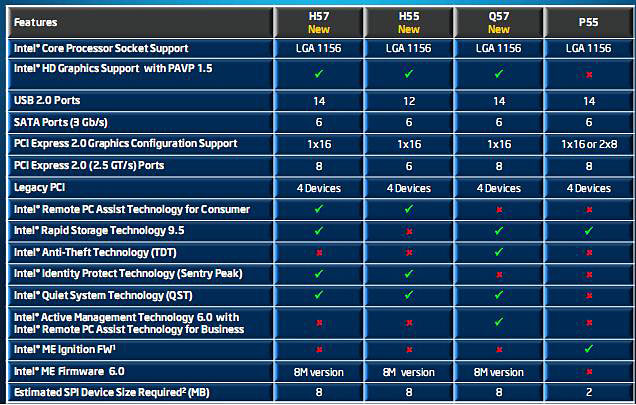 It is worth noting that, unlike many other processors, such as Lynnfield, in which the memory controller is located in the processor core, in Clarkdale series processors it is located directly in the graphics core. The core, in turn, is a crystal made using a slightly different technical process. It follows from this that engineers working in the ranks of Intel tried to combine both the Clarkdale core and the improved G45 in one package.
It is worth noting that, unlike many other processors, such as Lynnfield, in which the memory controller is located in the processor core, in Clarkdale series processors it is located directly in the graphics core. The core, in turn, is a crystal made using a slightly different technical process. It follows from this that engineers working in the ranks of Intel tried to combine both the Clarkdale core and the improved G45 in one package.
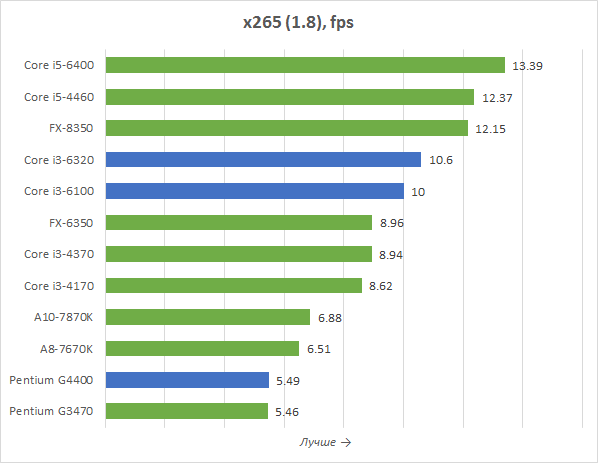 But without being distracted for too long, let’s return to the previously mentioned processors from Intel lines Core i3. This is a family dual core processors having 86-64 bit system. This device was created to satisfy both the average price and average performance ranges. The main task in the market for this type of processor was the desire to replace the outdated Pentium Dual-Core at that time, based on the earlier Intel Core 2 device.
But without being distracted for too long, let’s return to the previously mentioned processors from Intel lines Core i3. This is a family dual core processors having 86-64 bit system. This device was created to satisfy both the average price and average performance ranges. The main task in the market for this type of processor was the desire to replace the outdated Pentium Dual-Core at that time, based on the earlier Intel Core 2 device.
We must not forget that the basis of the work Core processor i3 are the four computing threads that it is able to support. This leads to the availability of a sufficient amount of working resources necessary for the fruitful and high-quality operation of the processor. This is quite enough for effective interaction with any modern software. This leads to the fact that the cost of such a processor will soon pay off.
As for the graphics component, this processor works with such graphic system, like Graphics Media Accelerator. It is capable of providing a high level of graphics clarity, both in videos and in modern games, not to mention solving any everyday tasks, such as demonstrating a desktop. In addition, this processor works closely with Intel Hyper-Threading technology, the main purpose of which is to allow both cores to perform two tasks simultaneously, which greatly increases the performance of the processor. This allows the Core i3 to be quite a powerful processor and gives it the ability to compete with many other models in terms of multitasking.
Another important component is Intel Smart Cache. This is cache memory, which is common to two cores at the same time, and is distributed between them depending on the load of a particular core. This allows any of the cores to quickly access data located in this memory block, which, in turn, greatly reduces the time delay during processor operation.
All of the above makes Intel Core i3 one of the most convenient for home and office use processors, since its basic configuration allows for relatively low price obtain a sufficiently high level of computer performance.
Read further:
The best processors of 2016 Intel fills Skylake processors innovation in hopes of reviving the PC industry




